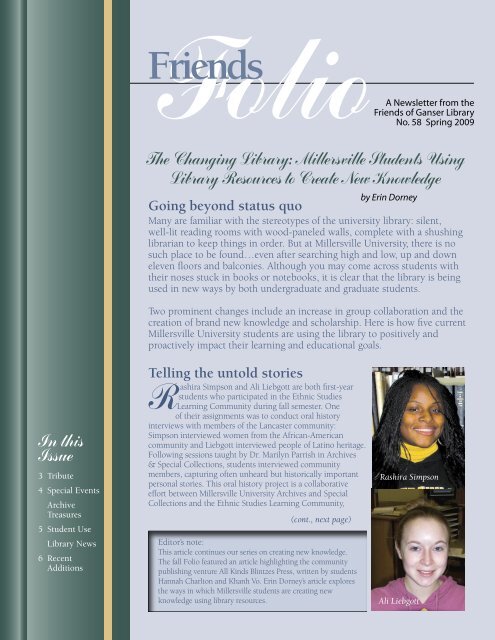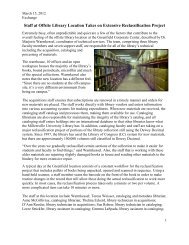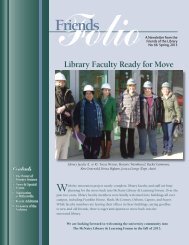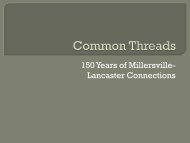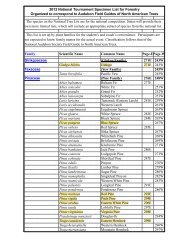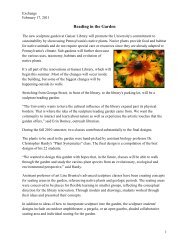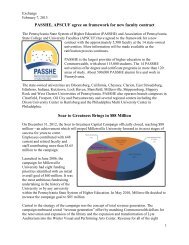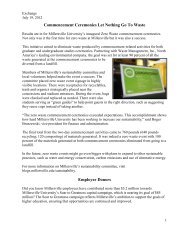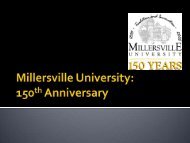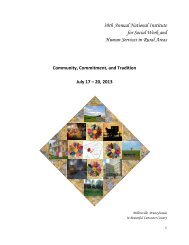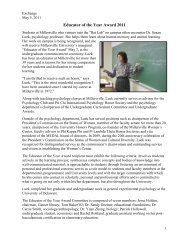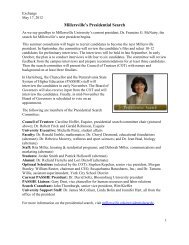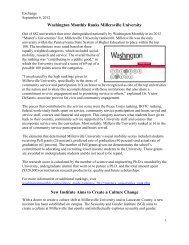Friends - Blogs @ Millersville University
Friends - Blogs @ Millersville University
Friends - Blogs @ Millersville University
Create successful ePaper yourself
Turn your PDF publications into a flip-book with our unique Google optimized e-Paper software.
Folio<strong>Friends</strong>A Newsletter from the<strong>Friends</strong> of Ganser LibraryNo. 58 Spring 2009The Changing Library: <strong>Millersville</strong> Students UsingLibrary Resources to Create New Knowledgeby Erin DorneyGoing beyond status quoMany are familiar with the stereotypes of the university library: silent,well-lit reading rooms with wood-paneled walls, complete with a shushinglibrarian to keep things in order. But at <strong>Millersville</strong> <strong>University</strong>, there is nosuch place to be found…even after searching high and low, up and downeleven floors and balconies. Although you may come across students withtheir noses stuck in books or notebooks, it is clear that the library is beingused in new ways by both undergraduate and graduate students.Two prominent changes include an increase in group collaboration and thecreation of brand new knowledge and scholarship. Here is how five current<strong>Millersville</strong> <strong>University</strong> students are using the library to positively andproactively impact their learning and educational goals.In thisIssue3 Tribute4 Special EventsArchiveTreasures5 Student UseLibrary News6 RecentAdditionsTelling the untold storiesRashira Simpson and Ali Liebgott are both first-yearstudents who participated in the Ethnic StudiesLearning Community during fall semester. Oneof their assignments was to conduct oral historyinterviews with members of the Lancaster community:Simpson interviewed women from the African-Americancommunity and Liebgott interviewed people of Latino heritage.Following sessions taught by Dr. Marilyn Parrish in Archives& Special Collections, students interviewed communitymembers, capturing often unheard but historically importantpersonal stories. This oral history project is a collaborativeeffort between <strong>Millersville</strong> <strong>University</strong> Archives and SpecialCollections and the Ethnic Studies Learning Community,(cont., next page)Editor’s note:This article continues our series on creating new knowledge.The fall Folio featured an article highlighting the communitypublishing venture All Kinds Blintzes Press, written by studentsHannah Charlton and Khanh Vo. Erin Dorney’s article exploresthe ways in which <strong>Millersville</strong> students are creating newknowledge using library resources.Rashira SimpsonAli Liebgott
2taught by Dr. Rita Smith Wade-El and Dr. Kimberly Mahaffy.The project is designed to collect and preserve local stories,contributing to a deeper understanding of LancasterCounty history. Simpson, a member of the AIM for SuccessProgram, spends up to 4.5 hours a day in the library andthrough this assignment has learned about a section ofthe library that was completely new to her: the SpecialCollections and Archives. Both Simpson and Liebgott agreethat the skills they have developed throughout the oralhistories project will influence their future studies here at<strong>Millersville</strong> and beyond. “This project allowed me to learnhow to interact with people and dig for information,” saidLiebgott. During the spring semester, students in threeclasses will be collecting additional oral histories fromthe African American community in Lancaster: HIST 273(African American History II with Dr. Tracey Weis), ENGL334/334H (African American Literature II with Dr. CalebCorkery), and PSYC 319 (Psychology of African Americanswith Dr. Rita Smith Wade-El).Contributing to thescholarly conversationDr. Carla Rineer (English) encourages her students “tocontribute to the scholarly conversation” by using primarysources as the basis for creative nonfiction essays. A widevariety of <strong>Millersville</strong> classes now engage students withprimary sources in Archives & Special Collections. Asthese students investigate and write about the uniquehistorical materials, they are contributing to the largerscholarly conversation while learning in new ways.Like Ethnic Studies Learning Community studentsSimpson and Liebgott, senior history major Ben Harveyshares praise for <strong>Millersville</strong> <strong>University</strong>’s unique resourcesand services. Harvey is currently working on his honorsthesis based on the T. EverettHarre Manuscript Collection,which documents the life ofa local writer. “I have beenable to use letters, transcriptsfor articles, and various othernotes to get an idea aboutthe outlook on life that Harrehad in the early 1900’s,” saysHarvey. While this extensivecollection is not completelyprocessed, much has beenaccomplished in preparingit for researchers, accordingBen Harveyto Library Technician Janet Dotterer who has worked withthe collection since its donation to the Library by KinseyBaker of the Book Haven in 2004. Utilizing this primarysource material offers Harvey a way to contribute to thescholarly conversation in his field. “It is really amazing asa history major to know that you are the first one workingwith a collection. I know that any information I find willbe new,” he adds. While primary resource use is commonin university libraries, the opportunity for undergraduatessuch as Harvey to contribute their own innovative researchto the field (based on one-of-a-kind materials) providesnot only a boost in confidence, but the opportunity to beviewed as a serious scholar and researcher.Unbinding creativityKatlyn Wolfgang, an art education major with plans tograduate in the spring of 2009, has seen the power ofthe library displayed in another creative and equallyinspirational manner.During her stintas president of the<strong>Millersville</strong> <strong>University</strong>Art Club in 2008,Wolfgang was theproject manager for“The Art of Punctuation”mural, overseeingcommunication, designand construction.The mural, currentlydisplayed on the firstKatlyn Wolfgangfloor of Ganser Library,consists of 50 individualcanvases celebratingpunctuation. Wolfgang attributes her further developmentof leadership, planning and advertising skills to her workon the mural project, stating that <strong>Millersville</strong> <strong>University</strong>library has provided “many resources to inspire thecontent, context and process of my artwork.” The projectwas so successful that Wolfgang gave up her own canvasto another artist, and potential contributors had to begraciously turned away. The mural project was initiatedby art liaison librarian Cheryl Collins and supported withthe library’s cultural enrichment funds. “It represents risk,being able to stick to a commitment, positive thinking, and<strong>Friends</strong>FolioThe <strong>Friends</strong> Folio is published twice a year (fall andspring) and distributed to the <strong>Millersville</strong> <strong>University</strong>community and <strong>Friends</strong> of Ganser Library.For more information or questions, contact us at (717) 872-3624, Special.Collections@millersville.edu or visit Archives& Special Collections on the 4th floor of Ganser Library.Editors: Marilyn McKinley Parrish, Priscilla OppenheimerGraphic Designer: Diane BlackCurrent and past issues of the Folio are available on theSpecial Collections website:www.library.millersville.edu/sc.cfm?Parent=3336<strong>Millersville</strong> <strong>University</strong> is an Equal Opportunity/Affirmative Action Institution. A member of thePennsylvania State System of Higher Education. 2936b-0309
the opportunity to develop and sustain the arts within a“book centered” environment,” said Collins. This uniquecollaboration between library faculty and <strong>Millersville</strong>students has resulted in a piece of artwork that remainsas a reminder of the different ways libraries can influencestudent learning and experiences. “The library seems toalways be there to help students in any way possible,”says Wolfgang, “They provide exceptional services that goabove and beyond what I initially expected.”Hands-on helping<strong>Millersville</strong> <strong>University</strong> graduate student Kari Millerspent her fall semester completing a half-time libraryassistantship under the direction of Education LibrarianJessica George. Even with a jam-packed class schedule,Miller found time to spend 10 hours per week onthe second floor of the library, working mainly withthe education and curriculum materials. Her projectsincluded weeding an outdated textbook collection,designing a bulletin board display, and carefully craftingand implementing a survey to ascertain what educationmajors want out of the second floor collection. “As anundergrad, I used the library for research and a quiet placeto focus on my work. As a graduate student, the libraryhas provided me with countless educational resources andan avenue to afford to further my education,” says Miller.“As I finish my career at <strong>Millersville</strong> and receive my teachercertification in the spring, I know that I can continueto use the library as a resource as I finish my master’sdegree in education. Whether it is for a children’s book,curriculum guide, or F.O.S.S. kit, I know that the libraryhas an abundance of resources readily available,” she adds.The <strong>Millersville</strong> <strong>University</strong> Library continues to investigateunique opportunities to involve students in gaininghands-on experience through assistantships, employmentand internships. During spring semester 2009, the librarywelcomes its first outreach support intern, senior Englishmajor Amy Pajewski.Books and moreThese five personal accounts demonstrate how currentstudents are using the <strong>Millersville</strong> <strong>University</strong> Library innew ways. Although a quick walk through the buildingwill display an expansive collection of monographs, thelibrary is much more than a storehouse for books. Pleasevisit us and discover the many other ways students areutilizing our resources, space, materials and services.For more information or to schedule a visit, please contactOutreach Librarian Erin Dorney at Library.Outreach@<strong>Millersville</strong>.edu or 717-872-3617.A Tribute toRobert SayreThe <strong>Friends</strong> of Ganser Library has established a newaward for students who make use of primary sources intheir History 105 papers, named in honor of the late Dr.Robert Sayre, assistant professor of history at <strong>Millersville</strong>.Bob regularly brought his classes to Archives & SpecialCollections and encouraged his students to use primarysources in their research and writing. Students werecaptivated by Bob’s fascinating explanations of the historyof African-American popular music and culture throughprinted and recorded music, andphotographs documenting the HarlemRenaissance (from the Carl Van VechtenManuscript Collection).Born in Tiffin, Ohio, Bob earned anundergraduate degree from HeidelbergCollege, a master’s in Divinity from theMethodist Theological School in Ohio,and a Ph.D. in American History fromOhio State <strong>University</strong>. Before comingto <strong>Millersville</strong> in 1981 to serve asdirector of United Campus Ministries,Bob was a Methodist pastor for severalOhio congregations. He began teachingcourses in United States history at<strong>Millersville</strong> in 1988. In addition tohis engagement with students in theclassroom, Bob’s involvements on theirbehalf included the Peace Coalition,the Commission on Cultural Diversity,Black Student Union, and the Exploratory program. Hewas an excellent teacher and scholar, beloved by hisstudents, colleagues, and friends. Bob is survived by hiswife Roma, two daughters Jennifer Croyle and AmandaPeiffer (both <strong>Millersville</strong> graduates), and their families.The first Robert Sayre awards will be given by the <strong>Friends</strong>at the spring banquet on April 7, 2009.3 3
Special EventsBook Sale, March 9-11The annual <strong>Friends</strong> of Ganser Library Book Sale was heldMarch 9-11, with a preview sale on March 8. The threedaysale offered a great selection of high-quality usedbooks. We are always interested in receiving new volumesfor the sale, particularly juvenile, art, music, and collectiblebooks. Contact Marilyn Parrish (872-3633) if you wouldlike to donate books for the sale, or to arrange for books tobe picked up.Spring Banquet & LectureThe <strong>Friends</strong> SpringBanquet & Lecturewas held Tuesday,April 7, 2009, at6 p.m. in the LehrRoom of the BolgerConference Center.The presentation onDiane Umblethe Amish responseto school violenceHermann Bontragerwas given by Dr. Diane Umble, communication & theatre,and Mr. Hermann Bontrager of Goodville Insurance.Fall 2009 <strong>Friends</strong>LectureDr. John Wallace, forensicentomologist and faculty memberin the biology department, willdiscuss his research and workwith students at the <strong>Friends</strong> FallLecture on September 8, at 7 p.m.,in the Lehr Room of the BolgerConference Center. Don’t miss thisfascinating opportunity to hearabout Dr. Wallace’s research and service to the scholarlyand forensic communities.Becoming a FriendPeople become <strong>Friends</strong> of Ganser Library whenthey make a donation to <strong>Millersville</strong> <strong>University</strong>and request mailings from the <strong>Friends</strong>. Encourageyour friends to become <strong>Friends</strong> of Ganser Librarythrough their support of <strong>Millersville</strong> <strong>University</strong>. Formore information, contact the <strong>Millersville</strong> <strong>University</strong>Development Office at (717) 872-3820.Treasures of the Archivesby Janet DottererIn the Archives, we have numerous autograph books of the students of<strong>Millersville</strong> State Normal School. These autograph books usually containedsignatures and quotes from friends and family members (similar to notessigned in yearbooks today). Our earliest one is from 1856 and belongedto Priscilla Stubbs. Miss Stubbs was from Peters Creek, Fulton Township,Lancaster County and attended the Normal School for one year. Herautograph book is typical of the many examples we have in the Archives,with signatures from both teachers and students. One signature does addsignificance to this particular autograph book, though. On the third page isthe signature of our first international student: J.P.F. Varro from Strasbourg,France. It is signed:J.P. Fernando VarroStrasbourgDept. du Bas RhinFrance.Be gentle always!44
Archives & Special Collections,Student Research 2008-2009Archives & Special Collections has been very busythis year with students from a variety of classes beingintroduced to specialized resources that support coursecurriculum, carrying out group and independent researchprojects, and participating in oral history projects. Ourgrowing collections in oral history, African Americanhistory, women’s history, health and hygiene, andchildren’s literature, added to already extensive collectionsin Pennsylvania German imprints and the history ofeducation, are providing strong support for studentlearning. Tangible evidence from other times facilitateslearning in new ways for students and extends classroomlearning through exploration outside the classroom.During the 2008-09 academic year, a total of 34 class sessionsand nearly 600 students have used our collections. The followingclasses have come to our area for instruction this year:Fall 2008EDFN 601 (Research Methods): Dr. Jeff Wimer; ENGL110 (Composition): Dr. Kasia Jakubiak; ENGL 311(Advanced Composition): Dr. Yufeng Zhang; ENGL 623(American Novel): Dr. Carla Rineer; ENGL 624 (Realismand Naturalism): Dr. Carla Rineer; HIST 105 (Craft ofHistory): Prof. Monica Spiese; UNIV 179 (Amish andthe Media): Dr. Diane Umble; UNIV 103.07 & UNIV103.00 (Ethnic Studies Learning Community): Dr.Kimberly Mahaffy and Dr. Rita Smith Wade-ElSpring 2009EDFN 376 (Whose School is it Anyway?): Dr. CherylDesmond; EDUC 333/535 (Literature for Children andYoung Adolescents): Dr. Lesley Colabucci; ENGL 110(Composition): Dr. Kasia Jakubiak; ENGL 237 (LiteraryResearch & Analysis): Dr. Carla Rineer; ENGL 334 (AfricanAmerican Literature): Dr. Caleb Corkery; GERM 331(German Civilization I): Dr. Leroy Hopkins; HIST 105(Craft of History): Prof. Monica Spiese; HIST 273 (AfricanAmerican History II): Dr. Tracey Weis; PSYC 319 (Psychologyof African Americans): Dr. Rita Smith Wade-El; SOCY329 (Sociology of Reproduction & Birth): Dr. Carrie Smith;SPED 313 (Intellectual Disabilities):Dr. Thomas NeuvilleIn addition to the work of the students in these classes,three students are making use of our materials for honorstheses: Hannah Charlton is working with Industrial Artsstudents’ letters to Dr. Osburn as servicemen duringWorld War II, Stephen Bleiler is examining religion on<strong>Millersville</strong>’s campus in the 1960s, and Ben Harvey isexploring the life and writing of T. Everett Harre.LibraryNewsAlong with the changing manner in which librariesare being utilized by students, faculty, and communitymembers, the roles of librarians are evolving as well. Newpositions continue to emergeas libraries develop better waysto serve the needs of diversepatrons. <strong>Millersville</strong> <strong>University</strong>Library recently created theposition of Outreach Librarianin order to fulfill some of thesenew avenues of communicationand customer service.As the Outreach Librarian,I have many responsibilitiesErin Dorneythat echo the traditional roleof academic librarianship.I provide reference service at the main reference desk,library instruction for relevant courses, and serve as liaisonlibrarian to assigned academic departments. However,the majority of my responsibilities lie in promoting andpublicizing the services, resources and events that the<strong>Millersville</strong> <strong>University</strong> Library has to offer. In addition, Idesign and coordinate Library communications includingsignage, logos, flyers and brochures; items contributingto the perception of the library as the integral intellectualcenter of campus.In short, I am here to ensure that our patrons know whatthe library has to offer and to engage in outreach to variousLibrary constituencies including <strong>Millersville</strong> <strong>University</strong>students, faculty, staff, prospective students, alumni,Lancaster-area community members, K-12 schools andbusiness leaders. How can we serve you? As the <strong>Millersville</strong><strong>University</strong> Library moves forward with a focus on creatingpositive relationships through personal outreach, yourfeedback, questions or concerns are always welcome! Formore information or to schedule a visit, please feel free tocontact me at any time.Readers can reach Outreach Librarian Erin Dorney atLibrary.Outreach@<strong>Millersville</strong>.edu or 717-872-3617.5 5
Recent AdditionsEach issue of the Folio lists acquisitions made possible through funding from the <strong>Friends</strong> of Ganser Library. Here arehighlights of some of the new materials added to the collection.We are grateful to Professor Emeritus Joseph Rousseau who donated his collection of rare math and sciencebooks to the university in the fall of 2008. This extensive collection will allow students and scholars access to rarematerials on the history of math and science from the 16th to the 19th centuries. The Rousseau collection will befeatured in the next issue of the Folio.EtiquetteTake My Advice: A Book for Every Home by Robert Kemp Phillip was published inLondon by James Blackwood and Co., in 1872. This small volume provides “completeand trustworthy information on everything relating to daily life” including such topicsas household management, domestic cookery, brewing, distilling, pets and pests. Thedomestic chemistry section covers types of soaps, perfumes, hair oils, tooth powders,inks, and hair dyes, and provides tips on washing blankets and carpets, preservationagainst lead poisoning, detecting arsenic and cleaning alabaster ornaments. Frombackgammon rules to abbreviations to the management of gold and silver fish, thisvolume contains advice for everyone.Mrs. E. B. Duffey’s Our Behavior: A Manual of Etiquette and Dress of the BestAmerican Society was published in Philadelphia in 1876. Duffey seeks to articulatea truly American etiquette for behavior and dress, as opposed to borrowing notionsabout proper conduct from the “Old World.” She notes “we should understand that theAmerican gentleman, though he may be lacking in the exceedingly polished, almostsubservient, outward forms of politeness of the Frenchman—though he may not beso self-asserting and condescending as the Englishman—is just as true a gentleman;and the type he represents should be more acceptable to the American people.Underneath an occasional appearance of brusqueness is hidden an even greater respectfor women—that touchstone of true gentility.” Chapters include titles, salutations,conversation, visits, courtship, and card playing, as well as Washington etiquette andetiquette of foreign courts.Manual of Politeness comprising the Principles of Etiquette, and Rules of Behaviourin Genteel Society for Persons of Both Sexes was published by W. Marshall & Co., inPhiladelphia in 1837. In addition to advice about clothing, dining and the ballroom, theauthor highlights the advantages of female conversation, discusses music and singing,and includes “Awkwardness,” a satire from Blackwood’s Magazine. In a chapter titled“American Peculiarities,” the author includes insights from a Scotchman who comparesAmericans to the English. When abroad, Americans are described as “talkative, noisy,often excessively impertinent, capricious, troublesome, either in his familiarity or in hisuntimely reserve; not quarrelsome, but so hasty, nevertheless, that he is eternally in hotwater.”6Planned Giving OpportunitiesConsider including <strong>Millersville</strong> <strong>University</strong> in your estate planning. For more information onplanned giving opportunities, including Ganser Library, <strong>Friends</strong> of the Library, or studentscholarships, contact the <strong>Millersville</strong> <strong>University</strong> Development Office at (717) 872-3820.
Health & MedicineWhat our Girls Ought to Know by Mary Studley, M.D., covers subjects relating tohealth and hygiene for young girls. Published in New York in 1889, Studley’s book is aresponse to many requests for a manual of lessons regarding the “laws of health.” Shediscusses food, breathing (this topic requires two chapters), nerves and nervousness,uses and abuses of dress. Studley concludes that “you can do and become all thingswhich may become a ‘perfect woman’ if you will but learn in the days of your youth,that all sickness and all suffering are the inevitable penalties of disobedience…I can dono better than to point you to the beautiful presence whose judicious and loving caremakes your school-life a daily proof that a women can become as efficient, and yet aswomanly, as a Principal of a Normal School as she can in the Home.”Comparative Physiognomy or Resemblances between Men and Animals, by JamesRedfield, M.D., was published in New York in 1852. Complete with 330 engravingsof the similarities between facial and head structure of humans and animals, thisvolume offers a fascinating look at a mid 19th century thinking about personality traits.Like phrenology, physiognomy offers the practitioner the opportunity to assess anindividual’s character based on physical characteristics or appearances.Compendium of Every Day Wants or Practical Information for the Millions, waspublished by Luther Minter (a member of the Altoona Bar) in Harrisburg in 1908. Soldby subscription only, Minter offered “Four Books in One Volume: A Complete Educatorand Legal Advisor, A Complete Household Guide, A Complete Guide to Health and aTreasury of General Information.” Minter’s Medical Department covers 100 pages andincludes subjects such as accidents and emergencies, poisons and poisoning, the sickroom, furniture, household pests, care of canary birds, and agricultural recipes.PovertyHow the Other Half Lives by Jacob A. Riis was published first in1890 with a second edition in 1909. Riis’ photographic journalismexposed life in the tenements of New York, including photographsand illustrations demonstrating the difficult living conditions ofimmigrants at the turn of the century. Riis published Children ofthe Poor in New York in 1892. Filled with illustrations, photos, andstories of children, this work explored kindergartens, industrialschools, boys clubs, the homeless, potter’s field, as well as thevarious groups living on the lower east side of Manhattan.Local ConnectionsThe Public School Singing Book was published by Murray and Stoek in Lancaster in1848 (“Opposite the Post Office, Queen St.”). This small volume contains the text (butno music) for songs to be used in schools.continued on back page7
Ganser LibraryP.O. Box 1002<strong>Millersville</strong>, PA 17551-0302<strong>Friends</strong> Folio via EmailHave you signed up to receive the <strong>Friends</strong> Folioelectronically? This environmentally friendly wayto read each issue of the Folio also provides thebenefits of earlier delivery and helps us reducecosts for mailing and printing. If you’d like toreceive the Folio electronically, email Special.Collections@millersville.edu to let us know.If you’d like to continue to receive the Folio inprint but want to receive email announcementsof upcoming <strong>Friends</strong> events, please email usthat information as well.Board Members 2008-2009President: Priscilla OppenheimerVice President: Lin CarvellSecretary: Lesley ColabucciTreasurer: Catherine GlassRecent AdditionsDr. Frederick Cook’s MyAttainment of the Pole waspublished in New York in 1911.Cook’s claim to have been the firstman to reach the North Pole wascontradicted by Robert Peary, whoclaimed that Cook lied about hisachievement. Cook made use of thewriting skills of T. Everett Harre,whose distinctive flowery languageis on display throughout the book.In later editions, Harre’s writingstyle was edited out. Despite theCook-Peary controversy, the bookdocuments survival in the Arcticthrough story and photographs. T.Everett Harre was an author fromMarietta. His manuscript collection(MS 251) is currently in use for anhonors thesis at <strong>Millersville</strong> (seeThe Changing Library, p. 1).continued from page 7Victor DeSantisNanette DietrichJoe LabantClarence MaxwellErin ShelorEx OfficioPhil BishopErin DorneyGerald EckertBeverly SkinnerCarrie SmithMichelle WhiteMarjorie White GreenawaltMartha WidmayerLeo ShelleyMarjorie WarmkesselMarilyn ParrishA copy of T. Everett Harre’s novelHeavenly Sinner (published byMacaulay in New York in 1935),containing an inscription by theauthor, was recently located andpurchased for our collection. Harreapparently sent this copy of hisbook to Charles Evans Hughes,Chief Justice of the Supreme Court,along with a letter which is alreadya part of the manuscript collection.


